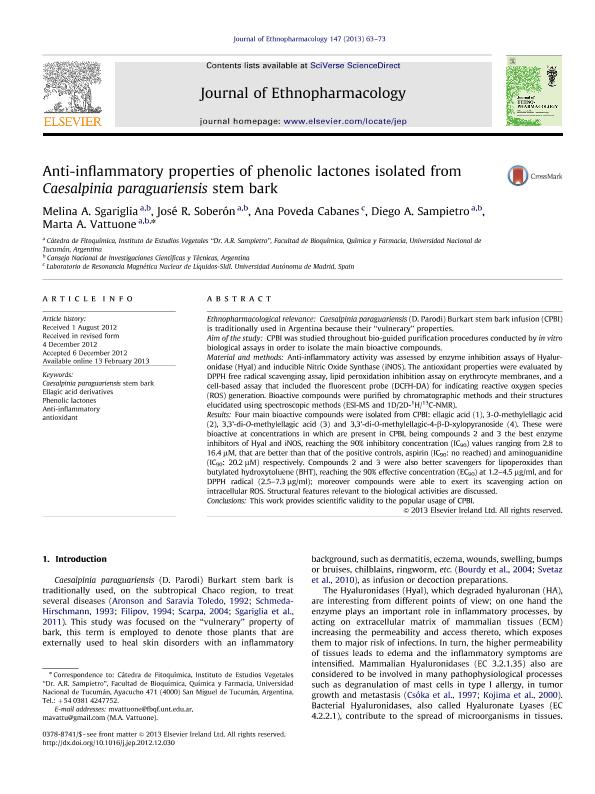Artículo
Anti-inflammatory properties of phenolic lactones isolated from Caesalpinia paraguariensis stem bark
Sgariglia, Melina Araceli ; Soberon, Jose Rodolfo
; Soberon, Jose Rodolfo ; Poveda Cabanes, Ana; Sampietro, Diego Alejandro
; Poveda Cabanes, Ana; Sampietro, Diego Alejandro ; Vattuone, Marta Amelia
; Vattuone, Marta Amelia
 ; Soberon, Jose Rodolfo
; Soberon, Jose Rodolfo ; Poveda Cabanes, Ana; Sampietro, Diego Alejandro
; Poveda Cabanes, Ana; Sampietro, Diego Alejandro ; Vattuone, Marta Amelia
; Vattuone, Marta Amelia
Fecha de publicación:
05/2013
Editorial:
Elsevier Ireland
Revista:
Journal Of Ethnopharmacology
ISSN:
0378-8741
Idioma:
Inglés
Tipo de recurso:
Artículo publicado
Clasificación temática:
Resumen
Ethnopharmacological relevance
Caesalpinia paraguariensis (D. Parodi) Burkart stem bark infusion (CPBI) is traditionally used in Argentina because their “vulnerary” properties.
Aim of the study
CPBI was studied throughout bio-guided purification procedures conducted by in vitro biological assays in order to isolate the main bioactive compounds.
Material and methods
Anti-inflammatory activity was assessed by enzyme inhibition assays of Hyaluronidase (Hyal) and inducible Nitric Oxide Synthase (iNOS). The antioxidant properties were evaluated by DPPH free radical scavenging assay, lipid peroxidation inhibition assay on erythrocyte membranes, and a cell-based assay that included the fluorescent probe (DCFH-DA) for indicating reactive oxygen species (ROS) generation. Bioactive compounds were purified by chromatographic methods and their structures elucidated using spectroscopic methods (ESI-MS and 1D/2D-1H/13C-NMR).
Results
Four main bioactive compounds were isolated from CPBI: ellagic acid (1), 3-O-methylellagic acid (2), 3,3'-di-O-methylellagic acid (3) and 3,3'-di-O-methylellagic-4-β-D-xylopyranoside (4). These were bioactive at concentrations in which are present in CPBI, being compounds 2 and 3 the best enzyme inhibitors of Hyal and iNOS, reaching the 90% inhibitory concentration (IC90) values ranging from 2.8 to 16.4 μM, that are better than that of the positive controls, aspirin (IC90: no reached) and aminoguanidine (IC90: 20.2 μM) respectively. Compounds 2 and 3 were also better scavengers for lipoperoxides than butylated hydroxytoluene (BHT), reaching the 90% effective concentration (EC90) at 1.2–4.5 μg/ml, and for DPPH radical (2.5–7.3 μg/ml); moreover compounds were able to exert its scavenging action on intracellular ROS. Structural features relevant to the biological activities are discussed.
Conclusions
This work provides scientific validity to the popular usage of CPBI.
Palabras clave:
Caesalpinia Paraguariensis
,
Corteza
,
Antiinflamatorios
,
Antioxidantes
Archivos asociados
Licencia
Identificadores
Colecciones
Articulos(CCT - NOA SUR)
Articulos de CTRO.CIENTIFICO TECNOL.CONICET - NOA SUR
Articulos de CTRO.CIENTIFICO TECNOL.CONICET - NOA SUR
Citación
Sgariglia, Melina Araceli; Soberon, Jose Rodolfo; Poveda Cabanes, Ana; Sampietro, Diego Alejandro; Vattuone, Marta Amelia; Anti-inflammatory properties of phenolic lactones isolated from Caesalpinia paraguariensis stem bark; Elsevier Ireland; Journal Of Ethnopharmacology; 147; 1; 5-2013; 63-73
Compartir
Altmétricas



